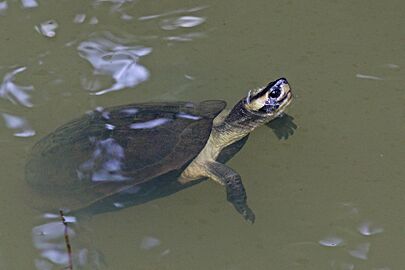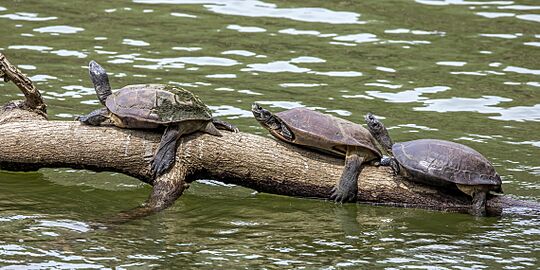Indian black turtle facts for kids
Quick facts for kids Indian black turtle |
|
|---|---|
 |
|
| Melanochelys trijuga | |
| Conservation status | |
| Scientific classification | |
| Genus: |
Melanochelys
|
| Species: |
trijuga
|
| Synonyms | |
|
click to expand
Emys trijuga Schweigger, 1812
Emys belangeri Lesson, 1834 Clemmys (Clemmys) trijuga Fitzinger, 1835 Melanochelys trijuga Gray, 1869 Emys trijuga var. madraspatana Anderson, 1879 Clemmys theobaldi Lydekker, 1885 Bellia theobaldi Lydekker, 1889 Nicoria trijuga Boulenger, 1889 Geoemyda [trijuga] trijuga Siebenrock, 1909 Geoemyda trijuga plumbea Annandale, 1915 Melanochelys trijuga Deraniyagala, 1939 Melanochelys trijuga trijuga Pritchard, 1979 Melanochelys triguja Highfield, 1996 (ex errore) Emys trijuga var. coronata Anderson, 1879 Nicoria trijuga var. coronata Bruner, 1908 Geoemyda trijuga coronata Siebenrock, 1909 Melanochelys trijuga coronata Pritchard, 1979 Melanochelys edeniana Theobald, 1876 Emys trijuga var. burmana Anderson, 1879 Nicoria trijuga var. edeniana Boulenger, 1889 Geoemyda trijuga edeniana Siebenrock, 1909 Melanochelys trijuga edeniana Deraniyagala, 1939 Emys trijuga edeniana Bourret, 1941 Geoemyda trijuga wiroti Reimann, 1979 Melanochelys trijuga wiroti Stubbs, 1989 Melanochelys edeniana edeniana Bour, 2002 Melanochelys edeniana wiroti Bour, 2002 Geoemyda indopeninsularis Annandale, 1913 Geoemyda trijuga indopeninsularis Smith, 1931 Melanochelys trijuga indopeninsularis Deraniyagala, 1939 Melanochelys edeniana indopeninsularis Bour, 2002 Melanochelys trijuga parkeri Deraniyagala, 1939 Geoemyda trijuga parkeri Mertens & Wermuth, 1955 Emys thermalis Lesson, 1830 Emys sebae Gray, 1831 Emys seba Gray, 1844 (ex errore) Geoclemys seba Gray, 1856 Clemmys thermalis Strauch, 1862 Melanochelys sebae Gray, 1870 Emys trijuga var. sebae Anderson, 1879 Nicoria trijuga var. thermalis Boulenger, 1889 Geoemyda trijuga thermalis Siebenrock, 1909 Melanochelys trijuga thermalis Deraniyagala, 1939 |
|
The Indian black turtle (Melanochelys trijuga), also called the Indian pond terrapin, is a medium-sized freshwater turtle. You can find it in South Asia.
Contents
What Does the Indian Black Turtle Look Like?
Even though it's called the "Indian black turtle," its top shell, or carapace, can be many colors. It might be reddish, dark brown, or even black. It often has cool yellow stripes along its shell. The bottom shell, called the plastron, is usually a plain brown color.
This turtle's face can have yellow or orange marks and spots. These colors can be different depending on which type of Indian black turtle it is. These turtles can grow to be about 38 to 45 centimeters (about 15 to 18 inches) long.
Where Do Indian Black Turtles Live?
You can find the Indian black turtle in many countries. These include India, Bangladesh, Myanmar, Sri Lanka, the Maldives, and Nepal. It might also have been brought to the Chagos Archipelago.
There are five main types, or subspecies, of this turtle. They live in different areas, but sometimes their homes overlap:
- M. t. trijuga: This is the peninsula black turtle, found in India.
- M. t. coronata: This is the Cochin black turtle, also found in India.
- M. t. indopeninsularis: Known as the Bangladesh black turtle, it lives in India and Nepal.
- M. t. parkeri: This type is found in Sri Lanka.
- M. t. thermalis: Called the Sri Lanka black turtle, it lives in India, the Maldives, and Sri Lanka.
The Indian black turtle makes its home in many kinds of watery places. This includes ponds, marshy areas, streams, and rivers. They also live in places made by people, like rice fields and watering holes.
-
M. t. coronata
Chambal River, Uttar Pradesh, India -
M. t. thermalis
Kandy, Sri Lanka
How Do Indian Black Turtles Live?
These turtles are most active in the early morning and evening. They spend most of the day relaxing and warming up in the sun. The type of turtle found in Sri Lanka has a flatter shell. It often spends its day hiding in burrows underground.
Indian black turtles usually look for food near the water's edge. They eat aquatic plants. They are also omnivorous, meaning they eat both plants and animals. Their diet can include water insects and even dead animals. Sometimes, you might see many Indian black turtles gathered around a large dead animal.
Reproduction and Life Cycle
Indian black turtles breed during the wet season. This usually happens between August and October. During this time, male turtles can become quite active. They chase the female and might gently bite her neck. The male then climbs onto the female's back to mate.
After mating, the female turtle digs a nest in the ground. Sometimes, she might even use a pile of rhinoceros or elephant dung! She uses her left back leg to dig the hole and her right back leg to push away extra dirt. A female turtle can lay two to six groups of eggs each year. The eggs hatch after about 60 to 65 days, usually during the summer.
Are Indian Black Turtles in Danger?
The IUCN (International Union for Conservation of Nature) says the Indian black turtle is of "least concern." This means it's not currently in danger of disappearing.
However, some types are more at risk. For example, the M. t. indopeninsularis subspecies is considered a threatened animal in Bangladesh. The population in Myanmar (M. t. edeniana) is thought to be vulnerable or even endangered.
In India and Nepal, these turtles are still quite common. Overall, the species is considered safe. When they are in danger, it's usually because people hunt them for food or to sell them as pets.





